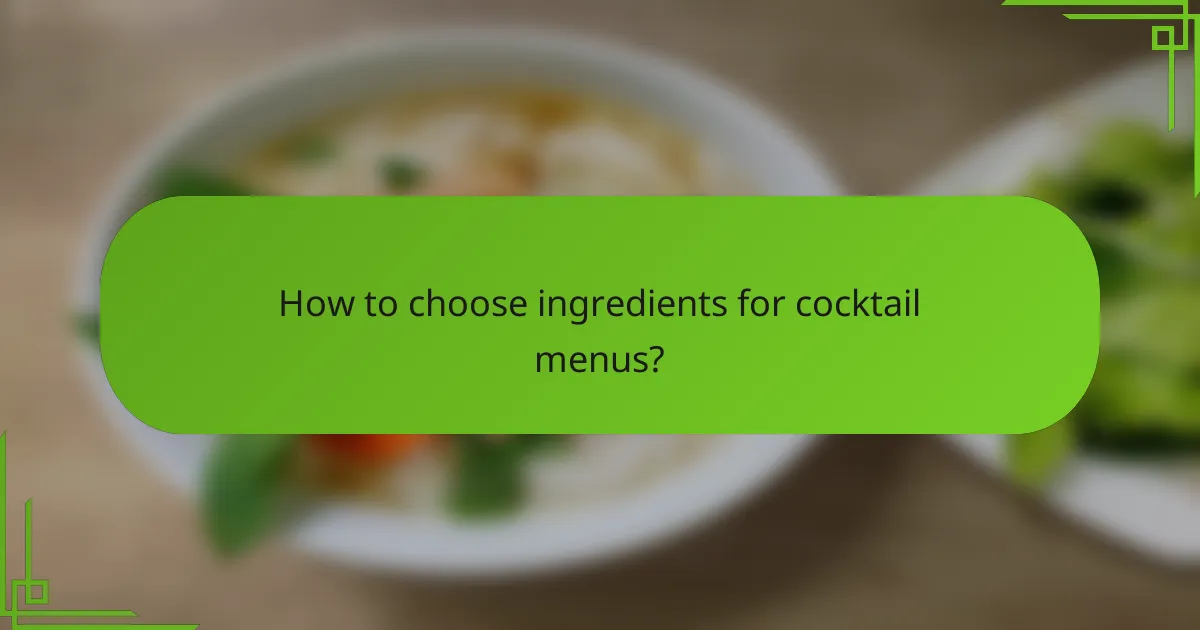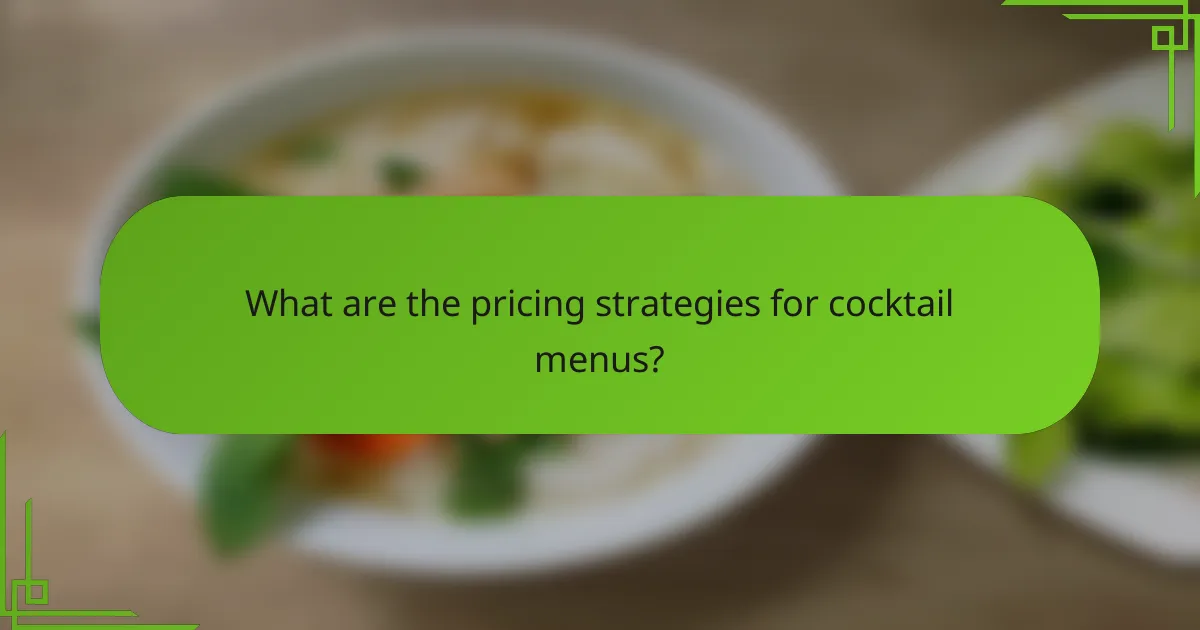Event-specific cocktail menus are thoughtfully designed to reflect the unique atmosphere and purpose of each occasion, enhancing the overall guest experience. By carefully selecting ingredients based on local sourcing and seasonal availability, these menus not only provide fresh and appealing options but also align with the event’s theme. Additionally, pairing cocktails with food can elevate flavors and create a cohesive ambiance that resonates with attendees.

What are event-specific cocktail menu themes in Los Angeles?
Event-specific cocktail menu themes in Los Angeles are curated selections of drinks designed to match the occasion’s atmosphere and purpose. These themes enhance guest experience by aligning flavors and presentations with seasonal, cultural, or corporate contexts.
Seasonal themes
Seasonal themes focus on ingredients that reflect the time of year, utilizing fresh produce and flavors that resonate with the season. For example, summer cocktails might feature citrus fruits and herbs like mint, while winter drinks could include spices such as cinnamon and nutmeg.
When planning a seasonal cocktail menu, consider local availability of ingredients and the overall vibe you want to create. A summer rooftop event might benefit from light, refreshing drinks, while a cozy winter gathering could lean towards warm, spiced beverages.
Cultural themes
Cultural themes celebrate specific traditions or cuisines, integrating unique ingredients and preparation methods. For instance, a Mexican-themed event could showcase cocktails like margaritas and palomas, using fresh lime and agave.
To create an authentic cultural experience, research traditional drinks and consider pairing them with appropriate appetizers or main dishes. This approach not only enhances the menu but also educates guests about the culture being represented.
Holiday themes
Holiday themes revolve around specific celebrations, incorporating festive flavors and colors. For example, a Halloween cocktail menu might feature dark spirits and garnishes like blackberries or activated charcoal, while a Christmas menu could include eggnog and cranberry-based drinks.
When designing a holiday cocktail menu, think about visual appeal and how the drinks can evoke the spirit of the occasion. Use seasonal garnishes and themed glassware to enhance the festive atmosphere.
Custom themes
Custom themes are tailored to individual events, allowing for complete creative freedom. This could involve crafting cocktails based on the host’s preferences, the event’s location, or even a specific color palette.
To develop a successful custom theme, engage with the host to understand their vision and preferences. Consider creating signature cocktails that reflect personal stories or memories, making the drinks more meaningful for guests.
Corporate themes
Corporate themes are designed to align with a company’s brand identity or event purpose, such as product launches or networking events. These menus often feature sophisticated cocktails that reflect the company’s image, using premium ingredients and elegant presentations.
When creating a corporate cocktail menu, ensure that the drinks are not only appealing but also easy to consume in a networking setting. Consider offering a mix of classic cocktails and innovative creations that can spark conversations among attendees.

How to choose ingredients for cocktail menus?
Choosing ingredients for cocktail menus involves considering local sourcing, seasonal availability, flavor profiles, and color coordination. These factors ensure that your cocktails are not only fresh and appealing but also resonate with the theme of your event.
Local sourcing
Local sourcing refers to obtaining ingredients from nearby farms or suppliers, which can enhance the freshness and quality of your cocktails. This practice supports local economies and reduces transportation costs and environmental impact.
When selecting local ingredients, consider the availability of fruits, herbs, and spirits in your area. For instance, using locally distilled spirits or seasonal fruits can create unique flavors that reflect the region.
Seasonal availability
Seasonal availability is crucial for ensuring that your ingredients are at their peak flavor and quality. Using ingredients that are in season can also reduce costs and improve sustainability.
Plan your cocktail menu around the seasons. For example, summer cocktails can feature fresh berries and citrus, while winter drinks might incorporate spices and hearty flavors. This approach not only enhances taste but also aligns with consumer preferences for freshness.
Flavor profiles
Flavor profiles are essential for creating balanced and enjoyable cocktails. Consider the primary flavors you want to highlight, such as sweet, sour, bitter, or savory, and how they interact with each other.
Experiment with complementary and contrasting flavors. For example, pairing a tart citrus with a sweet herbal liqueur can create a refreshing cocktail. Always taste your combinations before finalizing your menu to ensure a harmonious blend.
Color coordination
Color coordination plays a significant role in the visual appeal of cocktails. A well-coordinated color palette can enhance the theme of your event and attract guests’ attention.
Choose ingredients that not only taste good together but also look appealing when mixed. For instance, vibrant fruits like pomegranates or blueberries can add a pop of color, while garnishes like fresh herbs can provide contrast. Aim for a visually striking presentation that complements your overall event design.

What are popular cocktail pairings for events?
Popular cocktail pairings for events enhance the overall experience by complementing the food, theme, and season. Selecting the right cocktails can elevate flavors and create a cohesive atmosphere that resonates with guests.
Food pairings
When pairing cocktails with food, consider the flavor profiles of both. For instance, a zesty citrus cocktail like a Mojito pairs well with seafood, while a rich Old Fashioned complements grilled meats. Aim for balance; lighter dishes benefit from refreshing drinks, while heavier meals call for more robust cocktails.
Common pairings include:
- Spicy dishes with a sweet cocktail like a Piña Colada.
- Cheese platters paired with a dry Martini.
- Salads matched with a light Spritz.
Theme-based pairings
Theme-based pairings align cocktails with the event’s concept, enhancing the overall ambiance. For a tropical theme, consider drinks like Mai Tais or Blue Hawaiians, which evoke a beachy feel. A vintage theme might call for classic cocktails such as Manhattans or Sidecars.
Ensure that the cocktail names and presentations reflect the theme. For example, a masquerade ball could feature “Masked Mimosas” served in elegant flutes, adding to the event’s allure.
Seasonal pairings
Seasonal pairings take advantage of fresh ingredients and the mood of the time of year. In summer, refreshing cocktails like Watermelon Margaritas are ideal, while winter events can benefit from warm drinks like Spiked Hot Chocolate. Using seasonal fruits and herbs can enhance the flavor and presentation.
Consider the following seasonal options:
- Spring: Lavender Lemonade Vodka.
- Summer: Cucumber Gin Fizz.
- Fall: Apple Cider Mule.
- Winter: Cranberry Moscow Mule.

What are the pricing strategies for cocktail menus?
Pricing strategies for cocktail menus can significantly influence customer choices and overall event profitability. Common approaches include calculating cost per cocktail, offering package deals, and providing custom pricing options tailored to specific events.
Cost per cocktail
Cost per cocktail refers to the individual pricing of each drink on the menu. This strategy typically considers ingredient costs, labor, and overhead. For example, cocktails may range from $8 to $15, depending on the complexity and quality of ingredients used.
When setting prices, consider the target audience and event type. Upscale events may justify higher prices, while casual gatherings might require more competitive pricing to attract guests.
Package deals
Package deals offer a set price for a selection of cocktails, making it easier for guests to choose and for hosts to budget. These packages can include a fixed number of drinks or a variety of options for a single price, often ranging from $20 to $50 per person.
When creating package deals, ensure that the selections appeal to a broad audience. Including a mix of classic and signature cocktails can enhance the value and experience for guests.
Custom pricing
Custom pricing allows event planners to tailor cocktail costs based on specific needs, such as guest count, event duration, and desired cocktail variety. This flexible approach can accommodate budgets ranging from modest to extravagant.
To implement custom pricing effectively, communicate clearly with clients about their preferences and expectations. Providing a detailed breakdown of costs can help justify pricing and ensure satisfaction with the final menu.

What are the benefits of using local ingredients?
Using local ingredients in cocktail menus enhances flavor, supports local economies, and reduces environmental impact. By sourcing ingredients nearby, bartenders can create fresher, more vibrant drinks that reflect the region’s unique character.
Freshness
Local ingredients are often harvested at peak ripeness, ensuring maximum flavor and nutritional value. This freshness translates directly into cocktails, where the taste and aroma of ingredients can significantly elevate the drinking experience.
For example, using locally sourced herbs, fruits, and vegetables can enhance the complexity of a cocktail. Ingredients like fresh mint from a nearby farm or seasonal berries can make a noticeable difference compared to those that have traveled long distances.
To ensure freshness, consider establishing relationships with local farmers or markets. Regular visits can help you stay updated on seasonal offerings, allowing you to create a dynamic cocktail menu that changes with the harvest.


